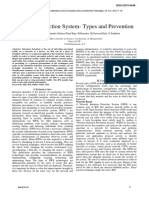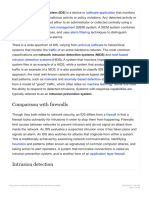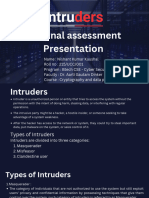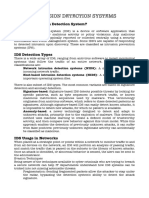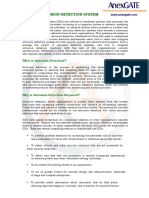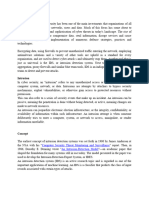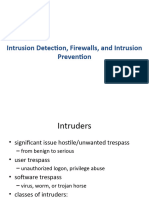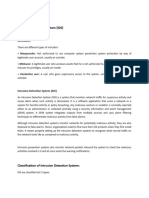March 2015 System Assessment and Validation for Emergency Responders (SAVER)
TechNote
Network Monitoring Tools
Network monitoring tools are software applications designed to monitor
and protect networks from intrusions and malicious traffic as well as
The U.S. Department of Homeland Security monitor the overall network health and performance. Law enforcement
(DHS) established the System Assessment and agencies use these tools to protect systems and databases, including
Validation for Emergency Responders (SAVER) records management systems, computer-aided dispatch systems, and gang
Program to assist emergency responders and fugitive intelligence databases, which contain information that must
making procurement decisions. Located within
the Science and Technology Directorate (S&T)
be kept secure and confidential per Federal Bureau of Investigation (FBI)
of DHS, the SAVER Program conducts Criminal Justice Information Services (CJIS) Security Policy and various
objective assessments and validations on other legal mandates. Network monitoring tools are also used by fire
commercially available equipment and systems, departments to protect their databases, which often include medical
and develops knowledge products that provide information that must be secured based on the federal Health Insurance
relevant equipment information to the
emergency responder community.
Portability and Accountability Act (HIPAA) privacy rules.
SAVER Program knowledge products provide Detecting and Preventing Threats
information on equipment that falls under the
categories listed in the DHS Authorized Thousands of data exchanges can occur daily on a typical network
Equipment List (AEL), focusing primarily on two rendering it vulnerable to unauthorized intrusion. The first layer of
main questions for the emergency responder protection is typically provided by a firewall, which blocks malicious
community: “What equipment is available?” Internet Protocol (IP) traffic by analyzing network activity and enforcing
and “How does it perform?” These knowledge
products are shared nationally with the policy based on a number of selected criteria (e.g., protocol types, IP
responder community, providing a life- and addresses, ports). Data that does not match policy is immediately rejected;
cost-saving asset to DHS, as well as to Federal, however, some malicious IP traffic activity is less obvious for the firewall
state, and local responders. to detect because it is hidden within approved network activities. The
The SAVER Program is supported by a network longer this type of IP traffic goes undetected, the greater the risk of
of Technical Agents who perform assessment security breaches, including those that involve financial data, criminal
and validation activities. records, or other sensitive information. Therefore, for improved
This TechNote was
prepared for the SAVER
protection against malicious IP traffic on their network, agencies often
Program by the Space utilize intrusion detection and prevention systems (IDPS) to protect
and Naval Warfare Systems against threats that may be missed by firewalls (Figure 1).
Center Atlantic.
For more information on this and other
technologies, contact the SAVER Program by
e-mail or visit the SAVER website.
E-mail: saver@hq.dhs.gov
Website: www.firstresponder.gov/SAVER
Reference herein to any specific commercial
products, processes, or services by trade
name, trademark, manufacturer, or otherwise
does not constitute or imply its endorsement,
recommendation, or favoring by the Figure 1. An IDPS protects against malicious IP traffic (red arrows)
U.S. Government. Neither the that may be missed by firewalls.
U.S. Government nor any of its employees
make any warranty, express or implied,
including but not limited to the warranties of
merchantability and fitness for a particular
purpose for any specific commercial product,
process, or service referenced herein.
�IDPS encompass both intrusion detection systems (IDS), which use software to automate the detection process,
and intrusion prevention systems (IPS), which use software to detect and attempt to deter potential breaches.
IDS monitor the IP traffic and passively analyze it for malicious patterns and violations of computer security
policies, acceptable use policies, and/or standard security practices. Once a malicious pattern or violation is
detected, the IDS alerts the proper system administrators so that appropriate action may be taken. IPS analyze
IP traffic actively and block malicious traffic, thus preventing an attack and protecting the network. When
intrusions are discovered, IDPS are designed to log all activity related to the breach. Logs are instrumental in
the investigative phase of a breach and may include the following information: the username of the host being
analyzed, the operating system and service pack information, and a list of installed products to determine if an
application can provide a countermeasure to a threat under review.
According to the National Institute of Standards and Technology (NIST), there are four classifications of IDPS
technologies:
1) Network-based, which monitors network traffic for particular network segments or devices and
analyzes the network and application protocol activity to identify suspicious activity.
2) Wireless, which monitors traffic on wireless networks and analyzes it to identify suspicious activity
involving wireless networking protocols.
3) Network behavior analysis (NBA), which examines network traffic to identify threats that generate
unusual traffic flows, such as distributed denial of service (DDoS) attacks, certain forms of malware,
and policy violations (e.g., a client system providing network services to other systems).
4) Host-based, which monitors the characteristics of a single host (e.g., client PC, server) and the events
occurring within that host for suspicious activity.
The majority of IDPS offer a variety of security capabilities, including information gathering, logging,
detection, and prevention. Agencies should consider using more than one type of IDPS, or an integrated
product, to address the different classifications of IDPS technologies. For example, an agency’s network may
have both wired and wireless network components. In this case, the agency may consider employing a wireless
IDPS in combination with one of the other classifications depending on the type of protection required and
characteristics of the wired network.
Performance and Health Monitoring
IDPS use network resources and, if not properly managed, can cause performance issues. While protection of
data is paramount, the network must also be properly monitored and managed. Performance and health
monitoring solutions monitor the performance of critical components within a network to identify hindrances
that may be affecting network performance. A typical solution can provide health reports related to
applications, databases, processor utilization, storage capacities, memory availability, power demands,
temperature, and a variety of other important metrics. These metrics are often presented in a real-time
dashboard and/or snapshot reports that can be generated on demand by system administrators. Performance and
health monitoring systems can alert system administrators of network issues before they reach critical status.
Summary
Network monitoring tools encompass IDS, IPS, and/or IDPS deployed at the host or network level to detect and
protect against unauthorized or irregular behavior on the network through software solutions. Network
monitoring tools also encompass software solutions to monitor the health and performance of a system.
Because no single IDPS technology can prevent all attacks, it is most effective to use a combination of firewalls
along with a combination of IDPS classifications to protect against unwanted security attacks.
Additional Information
National Institute of Standards and Technology. Guide to Intrusion Detection and Prevention Systems (IDPS)
(2007). http://csrc.nist.gov/publications/nistpubs/800-94/SP800-94.pdf. Accessed February 2015.
System Assessment and Validation for Emergency Responders (SAVER) Program. Intrusion Detection and
Prevention Systems Application Note (2011). https://communities.firstresponder.gov/web/saver-
community/home/-/document_library/view/486695/31943. Accessed February 2015.
2


